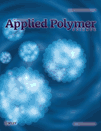Mechanical and thermal properties of graphite nanoplatelets reinforced polyarylene ether nitriles/bisphthalonitrile IPN system
Abstract
A new type of graphite nanoplatelets (GN) reinforced polyarylene ether nitriles (PEN)/bisphthalonitrile (BPh) interpenetrating polymer network with high strength and high toughness was synthesized and characterized. The results showed that GN and PEN had obvious synergistic effect on its properties of resulted BPh composites. Compared to pure BPh, with a loading of 10 wt % PEN and 10 wt % GN, the obtained composites exhibited excellent mechanical properties. In these systems, the flexural toughness and strength of BPh resin could be enhanced with the incorporation of PEN; meanwhile, GN could further improve the flexural modulus and thermal stability lowered by PEN. © 2012 Wiley Periodicals, Inc. J. Appl. Polym. Sci., 2013




